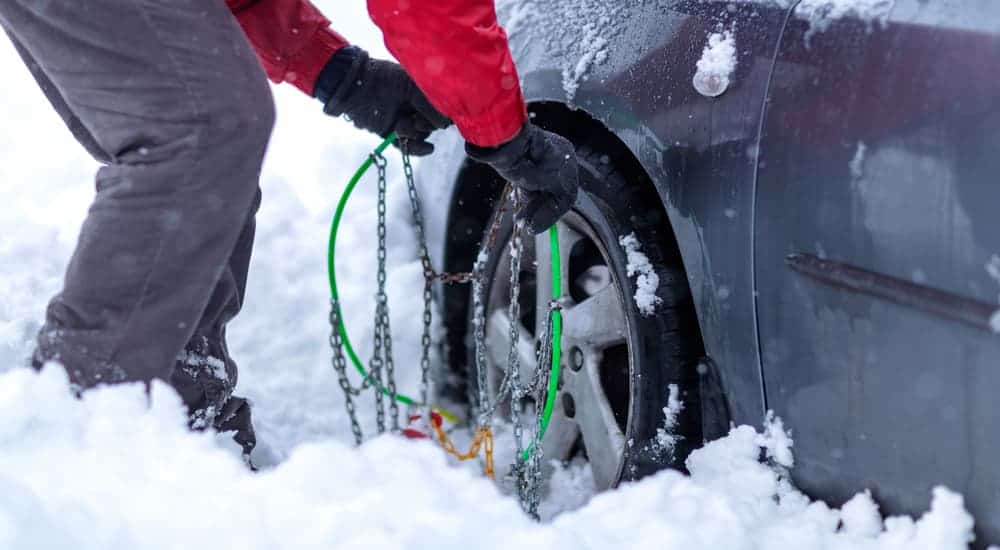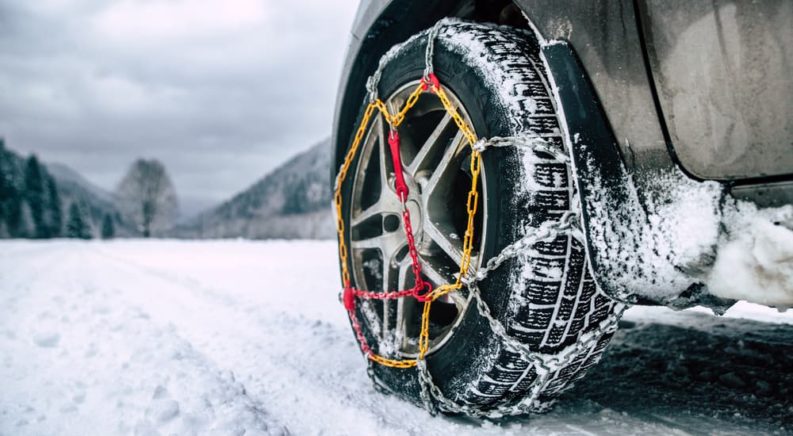Any person who has driven during the winter knows firsthand that winter weather is not always the most conducive for driving comfortably. Snow can accumulate quickly, which can cause tires to spin and cars to get stuck. Snow can also quickly melt and turn to slush, which can make braking more difficult. The worst is when that melted snow, especially with intermittent rain, freezes and creates a layer of black ice on the road. Black ice can lead to traction issues, as well as difficulty braking, and can cause quite a few unfortunate accidents. When facing winter driving, investing in a decent set of snow tires, which have specialized treads in order to make driving through winter weather easier, can help you stay on the road in adverse conditions. Sometimes, not even snow tires are enough. Luckily, for those who find themselves getting stuck even with snow tires, there exists another layer of winter protection: tire chains.
What are tire chains?
Tire chains are rather self-explanatory in name, in that they are chains which are attached to the outside of tires. They attach to the wheels that are responsible for spinning and generating power. For a front-wheel drive vehicle, this would be the front two wheels, and conversely the back two wheels for a rear-wheel drive vehicle. Although they are named after steel chain, tire chains are actually made of a number of different materials and vary greatly in size, design, and strength. They are typically sold in pairs and are designed to fit a specific tire size, although some are designed to be universal and can be adjusted to fit different sizes. Tire chains can significantly increase traction through both snow and ice, as well as improve overall braking distance. However, tire chains do have a few negative aspects to them as well. When using tire chains, the allowable speed of the vehicle drops significantly, to only 30 mph (50 km/h). Driving any faster could damage the tire chains, which conversely could damage your vehicle if they were to break off. The other negative aspect of tire chains is that they can be very harmful to developed roads, and should be kept off of any dry/barren surfaces.
The History of Tire Chains
Tire chains have actually been around in one way or another for a long time. They were invented officially in 1904 by Harry D. Weed of Canastota, New York. The theory of tire chains is actually older, as Weed initially came up with the idea for his tire chains after watching some drivers wrap rope and vine around their tires to help them through mud and snow. He obtained the US patent 0,768,495 for his tire chains, which he called “Grip-Tread for Pneumatic Tires.” This was a revolutionary creation for travel, as during the time almost no one in the Northeastern regions would drive during the winter time, due to the difficulty. Most roads were rolled in the winter time specifically for horse-drawn sleds/carriages, but the tire chains made it possible for even automobiles to manage. This invention had a hand in increasing the usage of automobiles and allowed them to phase-out other forms of transportation in the North.
Potential Issues/Legality
While tire chains are definitely a useful creation, they do not come without their potential issues, and also due to their limitations are actually outlawed in a few different places. In the US, almost every state has laws pertaining to their usage, with some more restrictive than others. A few states have a set period where tire chains can be used, usually from late fall-early spring. A handful of states have no laws on tire chain use, and they can be used freely. For a rundown of each state’s laws on tire chains, you can check out this list.
If used incorrectly, tire chains can have quite a few issues, and can even pose a potential to your vehicle and your safety. One of the most common tire chain failures comes from driving too quickly while using tire chains. The owner’s manual of the tire chains will have the required limit for that set of tire chains; generally, it is no more than 30 mph (50 km/h). Another common cause of failure comes from driving on clear and dry roads for too long. Tire chains are great for providing grip through snow and ice, and should really only be used for driving through those conditions. Tire chains have a habit of tearing up and damaging bare pavement, which will certainly weaken the tire chains as well. It can also cause the vehicle to slide while braking on dry pavement, which can cause an accident.

Another thing to look out for and remember when using tire chains is to make sure that the tire chains are secured tightly on the tire. Most owner manuals will recommend tightening the tire chains a second time after driving for a bit with them, and just generally checking the tightness from time to time, as they can loosen on their own while the vehicle is driving. If the tire chains were to become loose and slide off or break from being used improperly while the vehicle is driving, it can become a dangerous situation for you or other drivers. It can slap around inside of the wheel well, causing damage to the wheel as well as the driveshaft. It can even wrap around the axle, damaging it and severing brake lines. It is always recommended to exercise caution when using tire chains, but if used properly, they can make a world of difference when driving in the winter.
A Few Good Options
When it comes to purchasing tire chains, there are quite a few different options out there. It is important to remember the size of your tires when searching for tire chains, as most tire chains are designed for a specific size range. With that in mind, we’ve prepared a few of the top options available for cars, trucks, and SUVs:
SZ335 Shur Grip Z Passenger Car Tire Traction Chains:
These tire chains are some of the best available in the price range for cars. Due to the included rubber tighteners, they are easy to install, and will not loosen easily like other standard tire chains.
Glacier 1042 Passenger Cable Tire Chains:
Instead of standard steel chain, these chains are made from steel rollers on cable cross members, which makes them more rugged. They are for passenger cars, and benefit from type ‘S’ clearance, meaning they can be used on both front tires and back tires.
ZT729 Super Z LT Light Truck and SUV Tire Traction Chains:
These tire chains are designed to fit most light trucks and SUVs. These are one of the best values out there for tire chains. They are easy to install, and their design allows them to provide excellent grip and traction while also supplying a smooth ride.
Security Chain Company SZ143 Super Z6 Cable Chains:
These are some of the most versatile tire chains on the market. They are virtually universal and can be adjusted to fit most cars, trucks, and SUVs. On top of that, they have built-in rubber fasteners which prevent them from untightening, and their chain design delivers not only excellent performance but a smooth ride as well.

